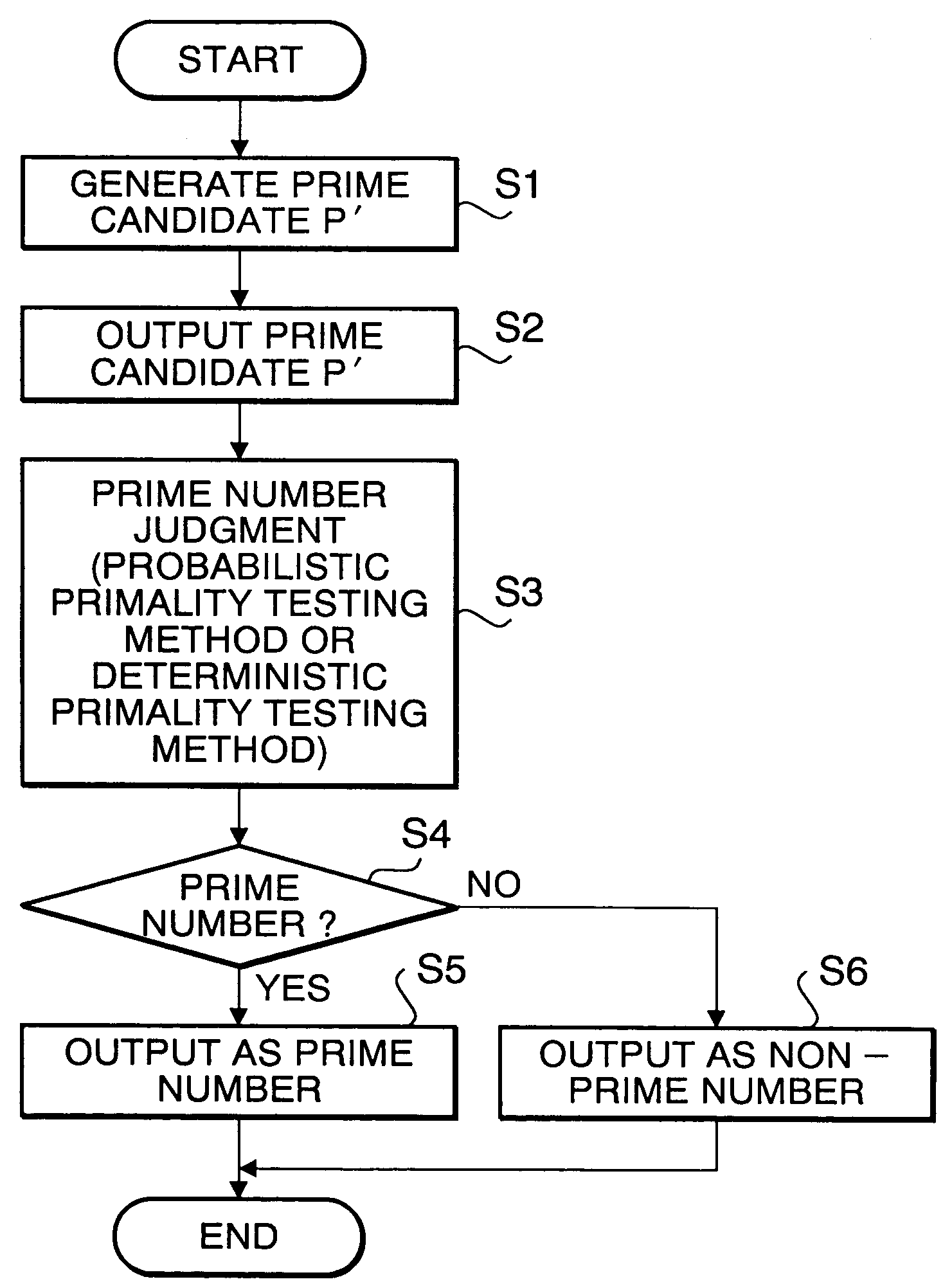Prime number generation method, prime number generation apparatus, and cryptographic system
- Summary
- Abstract
- Description
- Claims
- Application Information
AI Technical Summary
Benefits of technology
Problems solved by technology
Method used
Image
Examples
1st embodiment
Efficient Generation of Most Resistant Prime Numbers
[0105]After generating a prime candidate P′ using odd random numbers, and verifying that both P±1 are neither multiples of 8 nor multiples of 9, that P′ is subjected to trial divisions with the prime numbers from p3 to pn. When P′≡0, ±1 (mod pi), another prime candidate is generated and the process is re-executed from the beginning. Only those candidates which have passed all of the verifications are subjected to judgment to determine whether or not they are most resistant prime numbers. An algorithm for this first embodiment is indicated below, where oddrandom( ) is an odd random number generation function and isbestprime(P′) is a function for subjecting P′ to most resistant prime number judgment.
[0106]Algorithm for the first embodiment:
[0107]LOOP:[0108]P′←oddrandom( );[0109]if P′ mod 8=1 or 7[0110]then goto LOOP;[0111]if P′ mod 9=0 or 1 or 3 or 6 or 8[0112]then goto LOOP;[0113]for i=3 to n do[0114]begin[0115]if P′ mod pi=1 or 0 o...
2nd embodiment
Efficient Generation of Resistant Prime Numbers
[0123]A prime candidate P′ is generated using odd random numbers, and P′ is subjected to trial division with prime numbers from pi to pn. With pl such that pim, a prime candidate is regenerated only when P′≡0 (mod pi). For pi such that pi>pm, a prime candidate is regenerated when P′≡0, ±1 (mod pi), as in the first embodiment. Only those candidates that pass all of the verifications are subjected to judgment to determine whether or not they are resistant prime numbers. An algorithm for this second embodiment is indicated below, where is better prime(P′) is a function for subjecting P′ to resistant prime number judgment.
[0124]Algorithm for the second embodiment:
[0125]LOOP:[0126]P′←oddrandom( );[0127]for i=2 to n do[0128]begin[0129]if P′ mod pi=0[0130]then goto LOOP;[0131]if i>m[0132]then[0133] if P′ mod pi=1 or pi−1[0134] then goto LOOP;[0135]end[0136]if isbetterprime(P′)=TRUE[0137]then print P′, exit;[0138]else goto LOOP;
[0139]In this se...
3rd embodiment
[0141]Now it is conceivable that there could be a need to generate, at high speed, prime numbers that are comparatively resistant to the P±1 method, without the need for the degree of resistance afforded by either most resistant prime numbers or resistant prime numbers. In such a case, either the most resistant prime number judgment function isbestprime(P′) used in the first embodiment or the resistant prime number judgment function isbetterprime(P′) used in the second embodiment is replaced by the prime number judgment function isprime(P′). Then, prime numbers which are more resistant to the P±1 method than prime numbers generated by a conventional trial division method can be generated at very high speed.
[0142]FIG. 7 is a graph that plots the times required for generating 1000 prime numbers for each 20 bits from 100 bits to 300 bits, according to a third embodiment and to a conventional trial division method. In FIG. 7, the x marks indicate times required to generate prime numbers...
PUM
 Login to View More
Login to View More Abstract
Description
Claims
Application Information
 Login to View More
Login to View More - R&D
- Intellectual Property
- Life Sciences
- Materials
- Tech Scout
- Unparalleled Data Quality
- Higher Quality Content
- 60% Fewer Hallucinations
Browse by: Latest US Patents, China's latest patents, Technical Efficacy Thesaurus, Application Domain, Technology Topic, Popular Technical Reports.
© 2025 PatSnap. All rights reserved.Legal|Privacy policy|Modern Slavery Act Transparency Statement|Sitemap|About US| Contact US: help@patsnap.com



